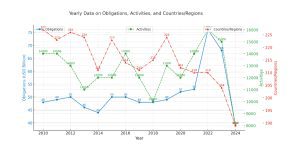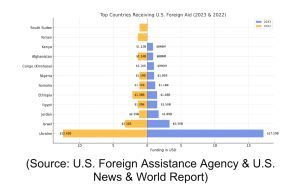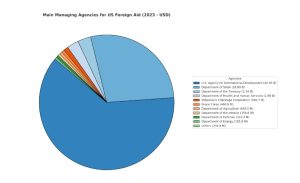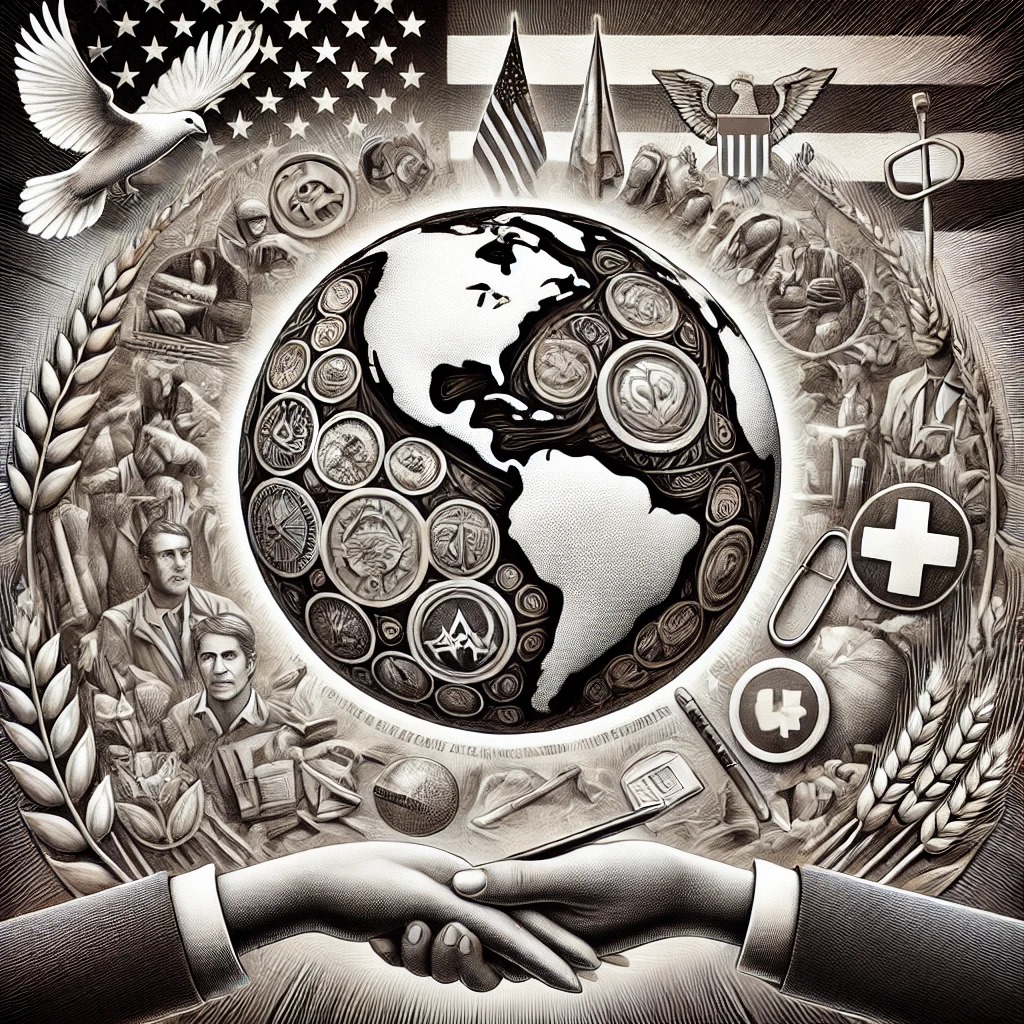U.S. foreign assistance has long been a cornerstone of its international relations, serving as a diplomatic tool that aligns with its global positioning as a major world power. Being one of the dominant world powers and the largest economy with a democratic form of governance, the country’s foreign policy assistance is crucial to its external policy approach to geopolitical developments. It supports its soft and strategic power projections.
The United States is the world’s largest donor, and the country’s foreign assistance reaches around 200 countries and regions worldwide annually. It mainly focuses on humanitarian relief, economic development, peacebuilding, and governance. Around 90% of the foreign aid is for economic development, while 10% is for military-related assistance.
Trends in U.S. Foreign Aid Allocation
Over the years, U.S. foreign assistance has fluctuated in scale and focus, reflecting both domestic debates and international needs. Despite these variations, foreign aid consistently constitutes around 1% of the federal budget, highlighting its significance within a carefully managed fiscal framework. Spending peaked at $76 billion in 2022, driven by urgent global challenges such as the COVID-19 pandemic, the Russia-Ukraine war, and the Israel-Hamas conflict. In 2023, the total spending was $68 billion, allocated to approximately 15,000 activities across 204 countries and regions. The current graph, taken from the United States Foreign Assistance Agency, and showing data since 2010, reflects this trend historically shown by U.S. aid data.

Areas of Focus
Economic development tops the list, as the 2023 obligations show, with $20 billion for it, followed by $14.43 billion for humanitarian assistance and peace and $10.74 billion for security efforts. Health initiatives accounted for $9.85 billion, while democracy, human rights, and governance programmes received $2.64 billion. Environmental sustainability and education, while receiving smaller portions of the total budget, remain integral to long-term developmental goals. This multifaceted approach ensures that U.S. aid addresses both immediate crises and systemic challenges.
Shifting Policies
Being one of the more elements of any U.S. administration, the complexities of foreign aid, from its allocation to its purpose, reflect shifting domestic priorities, international challenges, and geopolitical strategies from time to time.
Following his inauguration for a second term, President Donald Trump has temporarily suspended foreign aid disbursements for a period of 90 days. This suspension, according to the White House, aims to realign foreign assistance strategies with the administration’s foreign policy objectives. The freeze extends to all new obligations and disbursements of existing development assistance funds. However, exceptions have been made for Israel and Egypt, limited to emergency food aid and military funding.
This move is reminiscent of Trump’s previous tenure, where he proposed significant cuts to foreign aid. Between FY2018 and FY2021, while the Trump administration pushed for reductions, Congress often stepped in to maintain or even increase funding for key sectors such as global health, humanitarian crises, and countering the geopolitical influences of China and Russia.
Foreign assistance during the Biden administration was driven by the aftermath of the COVID-19 pandemic, global climate control efforts, and combating the rise of authoritarianism worldwide, says an analysis by the US Congressional Research Service. The Russia-Ukraine war and the escalating tensions in West Asia, with the Israel-Hamas conflict, further expanded the role of U.S. foreign assistance. Under Biden, foreign aid commitments witnessed a resurgence, with renewed focus on addressing pressing global challenges and fostering stability in conflict-ridden regions.
The top recipients of U.S. aid underscore its strategic priorities and global humanitarian approach. In 2023, Ukraine received $17.19 billion. Other significant beneficiaries included Israel ($3.3 billion), Jordan ($1.69 billion), and Egypt ($1.5 billion), highlighting enduring partnerships in regions of strategic importance.

Administrative Oversight
The administration of U.S. foreign aid involves a network of federal agencies. The U.S. Agency for International Development (USAID) leads these efforts, managing $42.45 billion of obligations in 2023. The Department of State of the United States government, with its $18.89 billion portfolio, plays a critical role in diplomatic initiatives tied to aid. Other agencies, such as the Department of the Treasury and the Department of Health and Human Services, oversee specialised programmes in areas like public health and economic stabilisation.

Directions of the 1980s prioritised Central America and the Middle East, with aid peaking in 1985 amid deficit reduction efforts. The 1990s marked a transition as the Cold War ended, shifting focus to Eastern Europe’s democratisation and important initiatives like the Wye River Peace Accords and Colombia’s counternarcotics efforts. Post-9/11, the 2000s saw a sharp rise in foreign aid, directed towards Afghanistan, Iraq, and global health programmes.
The 2010s brought a reduction in aid as military engagements in Iraq and Afghanistan waned, compounded by fiscal constraints from the Budget Control Act. However, foreign assistance rebounded in the 2020s amidst the COVID-19 pandemic and the Russia-Ukraine war, with aid levels reaching $76 billion in 2022.










